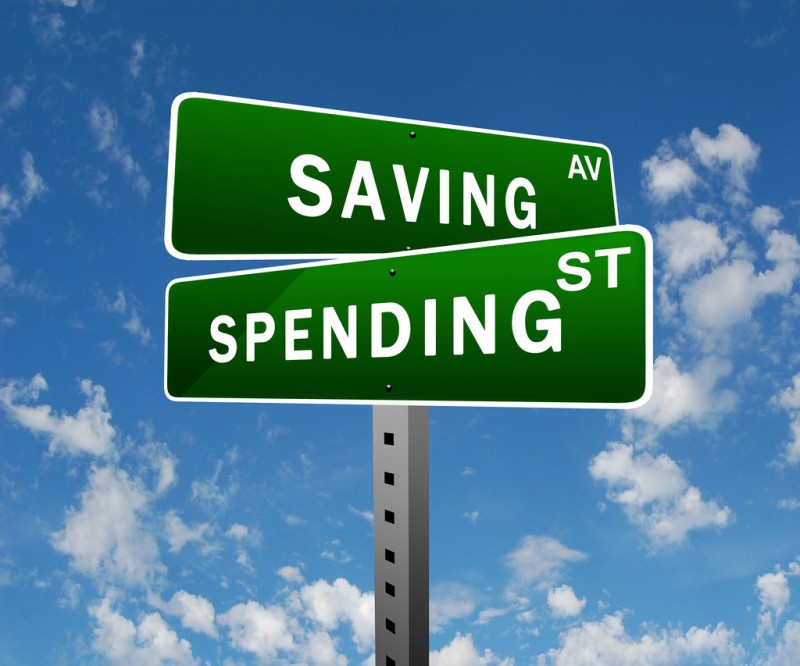George Dorgan
My articles My siteAbout meMy videosMy books
Follow on:LinkedINTwitterSeeking Alpha
CFA SocietyEconomicBlogs
The following article by Mark Scousen explains what one should prefer between consumer spending and savings/investments.
Based on Mark’s introduction will explain why the concerted action of Fed and ECB in Summer 2012, i.e. QE4 (or QE infinity) and European austerity was a mixture of both. Keith Weiner of the US Gold Standard Institute goes further, he clearly opts for savings.
What Drives the Economy: Consumer Spending or Saving/Investment?
by Mark Skousen, Original link
Journalists are often confronted with a major question in reporting economic news: What is the driving force behind economic performance, consumer spending or saving/investment?
When recession hits, most reporters focus on consumer spending. At the beginning of 2009, as spending figures fell to their lowest levels since records began, governments around the world were announcing stimulus packages at least partly aimed at putting money in people’s pockets to “jumpstart” their economies. Similarly, in the previous recession, in 2001, the French government, fearful that their citizens were not buying enough, increased government spending by 6%. Slowing retail sales in Europe “will spoil the party,” warned The Economist magazine. In Japan, economic analysts contended that Japanese consumers were saving too much, and the only way to jump start the giant Asian economy was to get Japanese consumers to stop saving and start spending. Yet economists also solemnly declare that saving and investment are keys to long term growth and issue warnings from time to time that the saving rate is too low in many countries. As Harvard economist N. Gregory Mankiw states in his popular textbook, Macroeconomics, “the saving rate is a key determinant of the steady-state capital stock. If the saving rate is high, the economy will have a large capital stock and a high level of output. If the saving rate is low, the economy will have a small capital stock and a low level of output.”
How can journalists resolve this apparent paradox of thrift?
The answer is found in correctly understanding GDP, leading indicators, and a seldom quoted national income statistic called “Gross Output,” issued by the U.S. Bureau
of Economic Analysis. Consumer Spending and Gross Domestic Output. The idea that consumer spending is the largest sector of the economy and therefore represents the driving force behind economic growth comes from Gross Domestic Product (GDP) statistics. Estimated quarterly in the industrial world, GDP represents the value of all final goods and services produced in a country during the year. Mathematically, GDP is represented as follows:GDP = C + I + G + (X – M), where
C = Personal consumption expenditures
I = Gross private domestic investment
G = Government consumption expenditures and gross investment
X = Exports
M = Imports.
In every developed nation, personal consumption expenditures rep resent by far the largest sector of GDP. For example, in the United States, GDP for 2008 is divided as follows:
Personal consumption expenditures (C ) = $10,058 billion
Gross private investment (I) = $2,004 billion
Government expenditures (G) = $2,883 billion
Exports (X) minus Imports (M) = -$665 billion
GROSS DOMESTIC PRODUCT (GDP) = $14,280 billion
In the U.S., consumption equals 70% of GDP; 65% in the UK; 58% in Germany; and 57% in Japan. Knowing this fact, reporters often follow retail spending patterns ask the key to future economic behavior and the stock market because, they note in the U. S., “consumer spending represents two-thirds of the economy.”
Mark continues:
What the Leading Economic Indicators Are Telling Us
Now let’s examine how important consumer spending and the investment sector are when it comes to the leading economic indicators. Here we see that both sectors influence economic performance, but the business sector appears to play a stronger role. Let’s take a look at the Index of Leading Economic Indicators in major countries. The Conference Board publishes indexes for nine countries.
Here are the results:
Of the nine leading indicators of Germany compiled by the Conference Board, two are linked to consumer spending: the consumer confidence index and the consumer price index for services. The rest are connected to earlier-stage production, such as inventory changes, new purchases of capital equipment, and new construction orders.France: Among France’s 10 leading indicators, two are consumer related, and the remainder are tied to commercial measures such as stock prices, productivity, building permits, the yield spread and new industrial orders.
UK: The UK’s leading indicators are linked to export volume, new orders in engineering industries, inventories, housing starts and money supply. Consumer Confidence Index is the lone consumer indicator.
None of Japan’s leading indicators are consumer related: overtime worked in manufacturing, business
conditions survey, labor productivity, real operating profits, and new orders for machinery and construction.
Mexico’s six indicators include a monthly survey of inventories,industrial construction, stock prices, interest rates and the cost of crude oil. Retail sales is a coincident indicator in Mexico.
– In the U. S., the Conference Board highlights the Consumer Confidence Index, while the other 9 indicators are only remotely related to final use, such as manufacturers’ new orders for consumer goods and materials,
building permits, average weekly manufacturing hours, stock prices, and new orders for non-defense capital
Now he comes to Keynes’ and Say’s Law:
Keynes’s Law and Demand-Driven Economics
Now let’s return to the question we posed at the beginning: What is the catalyst of economic growth and performance?
We see two factors at work, the demand side (consumption) and the supply side (investment) of the economy. In the short run, especially during a recession, most economists emphasize the importance of the demand side, and the role consumers play in keeping the economy going during a downturn.
This is known as Keynes’s Law, “demand creates its own supply,” named after the great British economist John Maynard Keynes (1883-1946).Say’s Law and Supply-Side Economics
The supply side of the economy is the main determinant of economic growth in the long run, when the economy is near full employment. The breakdown of GO and leading economic indicators supports this thesis.
An historical example may be helpful in explaining this point.
Why did the west coast of the United States (such as San Francisco, Portland and Seattle) boom in the 1990s?New technology in telecommunications and the Internet created a whole new level of wealth and prosperity in the region. Intel, Cisco Systems, and Microsoft became household names. Note that only after the technology boom began did consumer spending in cars, housing, travel, jewelry, and entertainment move sharply higher. Thus, we learn that consumption is the effect, not the cause, of prosperity, in the long run. This phenomenon is known Say’s law,
“supply creates its own demand,” named after the French economist Jean-Baptiste Say (1767-1832), which is making a comeback in economics these days (Kates 2003).The key to the economic boom of the 1990s was increasing technology, productivity, and entrepreneurship, what economists call the “supply side” of the economy. Technological, productive and entrepreneurial advances create new and better products for consumers at lower costs, which in turn open up new markets, increases income, and benefits consumption. However, when the technology boom ended in 2000, business investment fell, unemployment rose, and consumer spending slowed. During the 2000-03 recession, it was consumer spending that kept the economy from falling further (Keynes’s Law).
Throughout the business cycle, investment spending tends to be more volatile than consumer spending. Retail spending by consumers tends to be relatively steady throughout the ups and downs of the economy. Thus, it was not surprising that consumer spending held up well during the 2000-03 global recession. The recession was primarily a business recession. And once the economy recovered in 2003, it was business spending that finally made it happen.
Studies in business cycles and marketing demonstrate repeatedly that CEOs, entrepreneurs, capitalists and other business decision-makers are the primary activators of the economy, and determine when to start investing in capital again and turn the economy around. Government leaders cannot depend on
consumers to lead the recovery. They tend to be passive, responding to rather than creating new products and services.In normal times, increased savings expands the pool of capital investment, lowers interest rates, and allows firms to adopt new production processes, new technologies, and create new jobs. Thus, saving is just as much a form of spending as consumption, only a different form of spending, and in some cases, a better form of spending when it fulfills a need for more capital and investment.
Based on Mark’s explanation, I followed:
How the Fed and the ECB Applied Keynes’ and Say’s Law at the Same Time
The concerted actions in September 2012 by the two biggest central banks in the world reflected two fundamental economic principles:
- The Fed opted for Keynes’ law, “demand creates its own supply,” i.e. sustain U.S. housing with QE3, foster U.S. consumer spending and decrease their savings.
- The ECB opted for Say’s law, “supply creates its own demand,”. The conditionality implied an increase of the savings rate, higher investments and improved competitiveness for the European periphery, so-called “supply-side reforms”. Together with the promise to buy unlimited amounts of peripheral debt of 2 and 3 years with the OMT program, it helped to reduce current account deficits, yields and borrowing costs for the weak European states.
While the European leaders considered it important to stop excessive imbalances in Europe, somebody in the world needed to continue spending and keep the global economy afloat. Since the US dollar was the reserve currency and it was not expected that US borrowing costs would rise significantly, the Americans needed to take the burden of spending and risked maybe their long-term competitiveness.
Mark continues:
Tips for Journalists
It is vital to have a proper balance in the economy between consumption and saving/investment. Both are necessary to the foundation of wealth and prosperity. But consumer spending should not be promoted at the expense of saving
and investment.Be wary of statements such as:
“Consumer spending drives the economy.”
– “Consumer spending represents two-thirds of the economy.”
“Increasing saving won’t help the economy.”Remember that saving is an important ingredient of economic performance over the long run. Tax cuts that encourage saving and investment more than consumption are not necessarily bad. Avoid statements such as:
– “Tax cuts won’t stimulate the economy if they are saved.” Or:
– “Tax cuts for the wealthy are ineffective because the wealthy spend less than the middle class.”Remember that business and capital spending play a vital role in revitalizing a slumping economy. Typically
the first signs of recovery come from business, not consumer, spending in the form of industrial production, capital formation, and construction, both commercial and residential.Do not criticize consumers for retrenching and reducing consumer debt during a downturn. It is a natural response to uncertainty over their jobs and the outlook for the economy.
Make sure you understand and use properly your nation’s national income statistics, including Gross Domestic Product (GDP), the new Gross Output (GO) figure, and leading economic indicators.
Keep in mind that most leading economic indicators are business and investment related, not consumer related.
Say’s Laws on Mises.org
Latest “Gross Output” data by Bureau of Economic Analysis, U. S. Department of Commerce.
Go to www.bea.gov
and look under “GDP by Industry” then “interactive tables” for the latest GO data by industry:
Conference Board (leading economic indicators updated regularly for the U.S., Australia, France, Germany, Japan, Korea, Mexico, Spain and the U.K.):
On Say’s Law and its relevance today
Excellent source for economic statistics and graphics (primarily US):
www.economagic.com
Mark Skousen, The Structure of Production. New York University Press, 1990.
Steven Kates, ed., Two Hundred Years of Say’s Law: Essays on Economic Theory’s Most Controversial Principle. Northampton, Mass: Edward Elgar, 2003
No related photos.






















